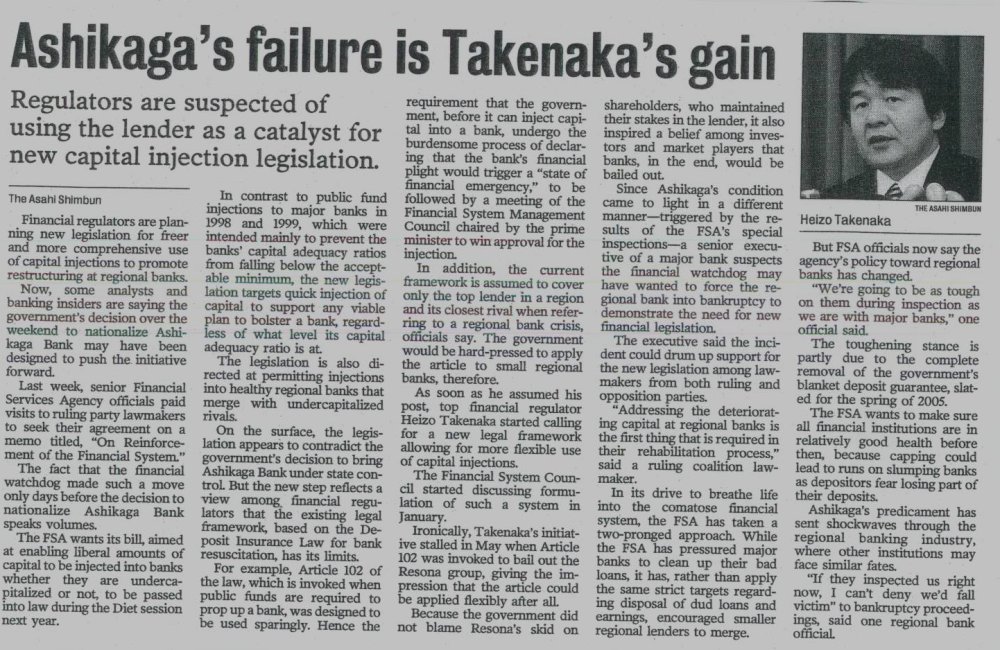
Ashikagafs failure is Takenakafs gain
Regulators are suspected of using the lender as a catalyst for new capital injection legislation.
The Asahi Shinbun
Financial regulators are planning new legislation for freer and more comprehensive use of capital injection to promote restructuring at regional banks.
Now, some analysts and banking insiders are saying the governmentfs decision over the weekend to nationalize Ashikaga Bank may have been designed to push the initiative forward.
Last week, senior Financial Services Agency officials paid visits to ruling party lawmakers to seek their agreement on a memo titled, gOn Reinforcement of the Financial System.h
The fact that the financial watchdog made such a move only days before the decision to nationalize Ashikaga Bank speaks volumes.
The FSA wants its bill, aimed at enabling liberal amounts of capital to be injected into banks whether they are undercapitalized or not, to be passed into law during the Diet session next year.
In contrast to public fund injections to major banks in 1998, and 1999, which were intended mainly to prevent the banksf capital adequacy ratios from falling below the acceptable minimum, the new legislation targets quick injection of capital to support any viable plan to bolster a bank, regardless of what level its capital adequacy ratio is at.
The legislation is also directed at permitting injections into healthy regional banks that merge with undercapitalized rivals.
On the surface, the legislation appears to contradict the governmentfs decision to bring Ashikaga Bank under state control. But the new step reflects a view among financial regulators that the existing legal framework, based on the Deposit Insurance Law for bank resuscitation, has its limits.
For example, Article 102 of the law, which is invoked when public funds are required to prop up a bank, was designed to be used sparingly.
Hence the requirement that the government, before it can inject capital, before it can inject capital into a bank, undergo the burdensome process of declaring that the bankfs financial plight would trigger a gstate of financial emergency,h to be followed by a meeting of the Financial System management Council chaired by the prime minister to win approval for the injection.
In addition, the current framework is assumed to cover only the top lender in a region and its closest rival when referring to a regional bank crisis, officials say. The government would be hard-pressed to apply the article to small regional banks, therefore.
As soon as he assumed his post, top financial regulator Heizo Takena started calling for a new legal framework allowing for more flexible use of capital injections.
The financial System Council started discussing formulation of such a system in January.
Ironically, Takenakafs initiative stalled in May when Article 102 was invoked to bail out the Resona group. giving the impression that the article could be applied flexibly after all.
Because the government did not blame Resonafs skid on shareholders, who maintained their stakes in the lender, it also inspired a belief among investors and market players that banks, in the end, would be bailed out.
Since Ashikagafs condition came to light in a different manner-triggered by the results of the FSAfs special inspections- a senior executive of a major bank suspects the financial watchdog may have wanted to force the regional bank into bankruptcy to demonstrate the need for new financial legislation.
The executive said the incident could drum up support for the new legislation among lawmakers from both ruling and opposition parties.
gAddressing the deteriorating capital at regional banks is the first thing that is required in their rehabilitation process,h said a ruling coalition lawmaker.
In its drive to breathe life into the comatose financial system, the FSA has taken a two-pronged approach. While the FSA has pressured major banks to clean up their bad loans, it has, rather tan apply the same strict targets regarding disposal of dud loans and earnings, encouraged smaller regional lenders to merge.
But FSA officials now say the agencyfs policy toward regional banks has changed.
gWefre going to be as tough on them during inspection as we are with major banks,h one official said.
The toughening stance is partly due to the complete removal of the governmentfs blanket deposit guarantee, slated for the spring of 2005.
The FSA wants to make sure all financial institutions are in relatively good health before then, because capping could lead to runs on slumping banks as depositors fear losing part of their deposits.
Ashikagafs predicament has sent shockwaves through the regional banking industry, where other institutions may face similar fates.
gIf they inspected us right now, I canft deny wefd fall victimh to bankruptcy proceedings said one regional bank official.
end